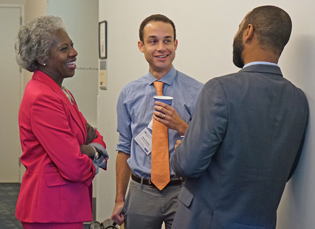Focus on Science
NIH’s First Future Research Leaders Conference
On September 17, a group of postdocs and early-stage faculty converged on the NIH campus for a day and a half of science during the 2015 NIH Research Festival (http://researchfestival.nih.gov/2015/future_leaders.shtml). The 28 scientists—all of diverse backgrounds—make up the inaugural class of the NIH Future Research Leaders (FRLs). This pilot program was organized and run by NIH’s Chief Officer for Scientific Workforce Diversity, Hannah Valantine, and her staff.

PHOTO BY CHRISTINE STANFILL, OD
The Future Research Leaders Conference brought early-career scientists of diverse backgrounds to NIH for a day and a half in September. From left, NIH’s Chief Officer for Scientific Workforce Diversity, Hannah Valantine, and conference attendees Mark Buckley (University of Rochester) and Willieford Moses (University of California, San Francisco).
The FRLs traveled from across the nation and represented the country’s top institutions: Duke University (Durham, North Carolina) and Tufts University (Boston), the Johns Hopkins University (Baltimore) and Stanford University (Stanford, California), St. Jude Children’s Research Hospital (Memphis, Tennessee), Brown University (Providence, Rhode Island), and many others. They are early-career scientists working in biomedical pursuits ranging from structural biology to women’s health. They all come from groups underrepresented in biomedicine, and many had received an NIH Research Supplement to Promote Diversity in the past (see sidebar).
FRL Conference attendees listened to presentations from NIH’s senior leadership. NIH Director Francis Collins spoke about NIH’s long track record of leading scientific discovery, and NIAID Director Anthony Fauci gave a riveting account of how a future without the human immunodeficiency virus and AIDS is within our grasp through tangible steps in research and policy. Both scientists conveyed a bright future for the FRLs, who will be tomorrow’s scientific leaders and contribute to biomedical innovation through both the diversity of their backgrounds and their excellence in the lab.
“We know that diversity of all kinds promotes innovation in thinking—in approaches, in collaboration, and in the choice of what to study in the first place,” said Valantine, a notion underscored by Collins in his lunchtime remarks to the group. Diversity is central to research excellence, he affirmed as he spoke about NIH’s strong commitment to change its complexion to one that looks like the rest of America.
FRLs were excited to share their science.
“I want to be part of the solution,” said FRL Iris Navarro-Millan during an oral presentation of her work on developing patient-centered outcomes in people with rheumatoid arthritis (RA). A Puerto Rico native, she earned an M.D. in Mexico and did fellowship training at the University of Alabama at Birmingham (Birmingham, Alabama), where she now holds a faculty position. She is currently working on reducing cardiovascular risk in people with RA, a risk they often are unaware they have, she noted.
FRL Casey Overby, an assistant professor at the University of Maryland School of Medicine (Baltimore), is interested in translating the results of genomic medicine into clinical and population-based health-care settings. A bioinformaticist by training, she is intrigued by the power—and potential peril—of big data on people’s lives and health.
Some FRLs, such as Willieford Moses, maintain a dual focus on basic and applied research. An M.D. by training, Moses is currently doing postdoctoral research to build an artificial kidney in Shuvo Roy’s BioDesign lab at the University of California at San Francisco (San Francisco).
In addition to presenting their research, each FRL was paired with two senior investigators (many of them scientific directors or branch chiefs) in face-to-face meetings. The group also shared a poster session with the intramural research program scientific directors at the Research Festival, which also featured the now-popular annual bake-off. Thankfully, that event seemed to confirm that intramural scientists can manage as well in the kitchen as they do in the lab.
NIH Research Supplement to Promote Diversity
NIH has supported the Diversity Supplement Program for more than a quarter-century (DSP; http://grants.nih.gov/grants/guide/pa-files/PA-08-190.html). DSP funds enable NIH-funded investigators to provide support in their labs for individuals from diverse backgrounds. The program, supported by nearly all NIH institutes and centers, has been successful by a range of metrics. A 2015 report from the National Institute of General Medical Sciences stated that about 65 percent of all DSP-supported graduate students and postdocs landed research careers in academia or industry or are government-employed in career sectors similar to those reported for the U.S.-trained Ph.D. workforce as a whole (NIGMS Analysis of Supplements to Enhance Diversity 1989-2006: http://www.nigms.nih.gov/Research/mechanisms/Documents/DSPOutcomesReport5282015.pdf)
This page was last updated on Monday, April 25, 2022
